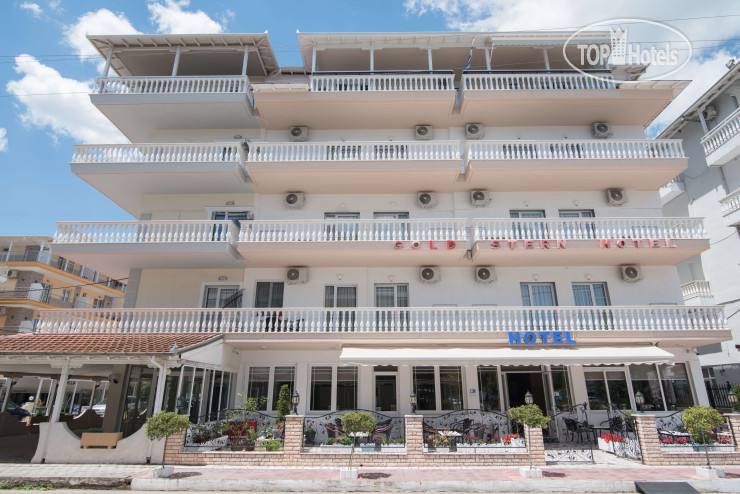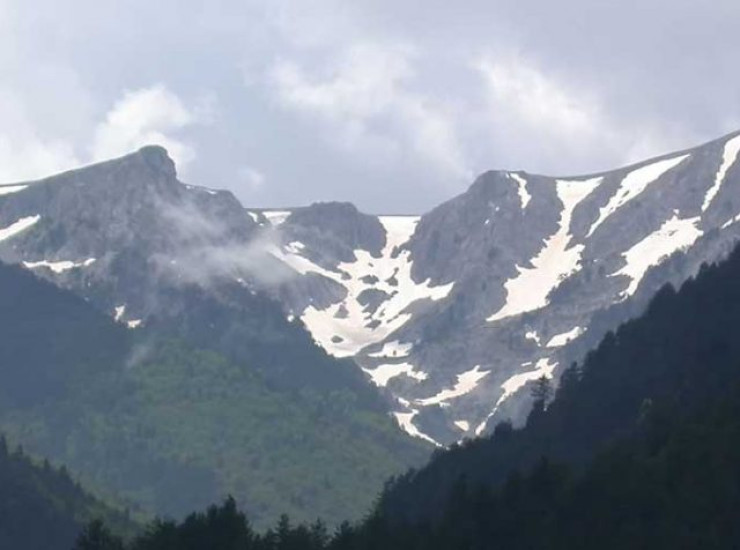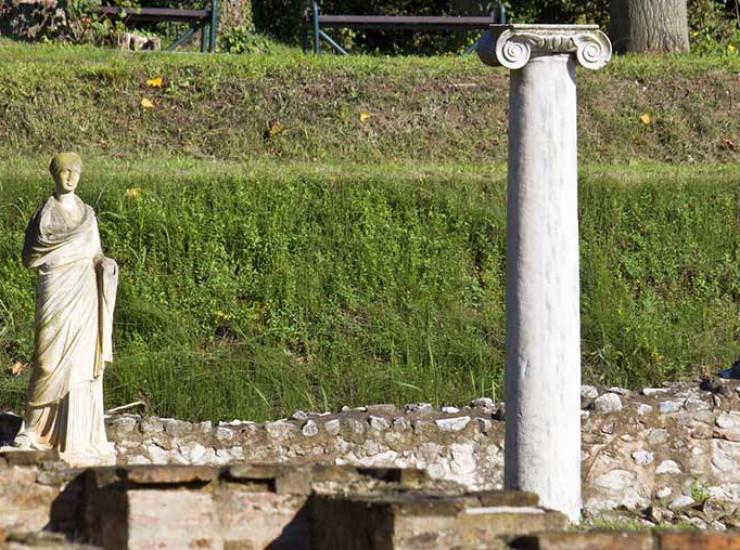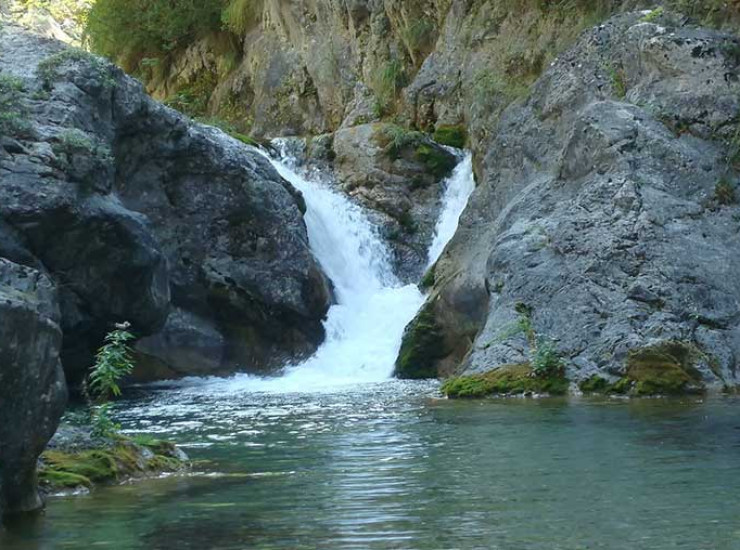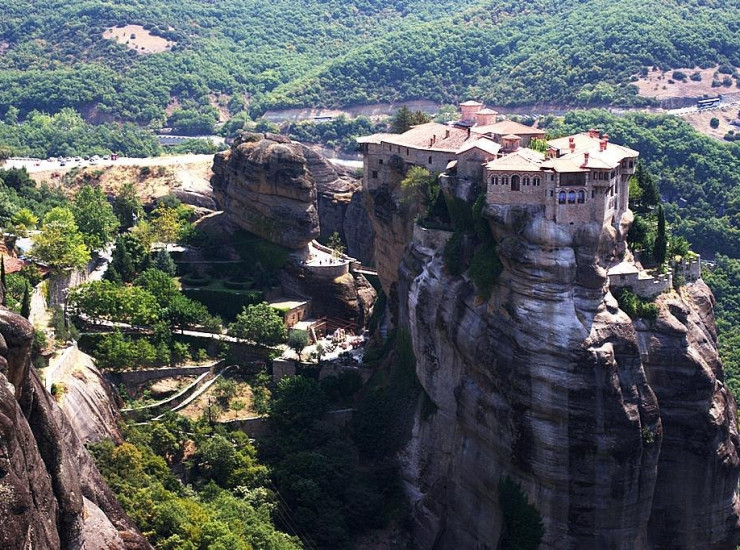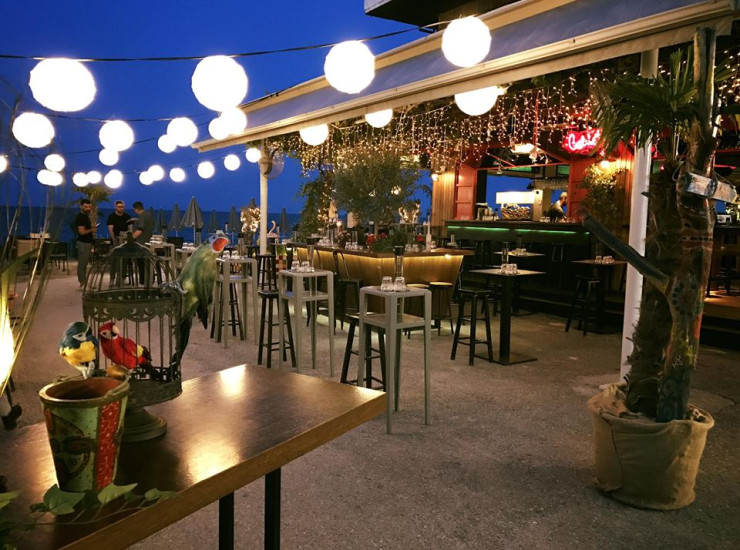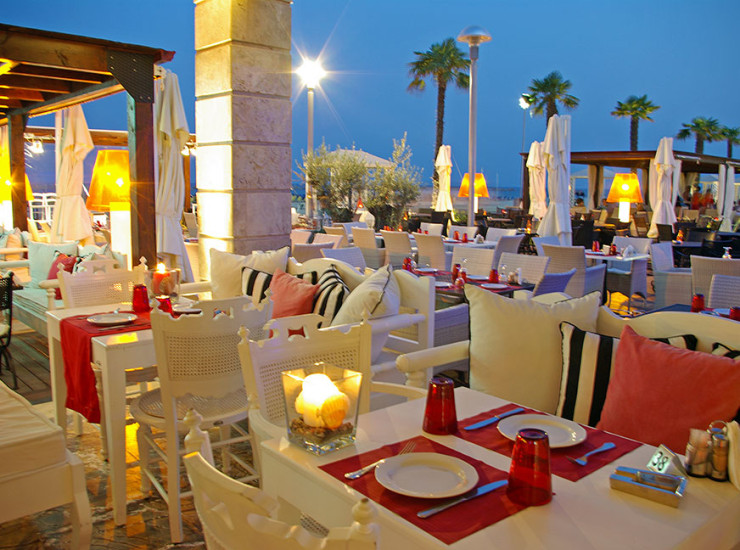General information
General information
| Official name | Gold Stern 3* |
| Declared hotel category |
|
| Property type | Hotel - 17 rooms |
| Concept | 18 + |
| Hotel location | Paralia Katerinis Paralia Katerini (Pirea) Central Macedonia Greece |
| Location type | near the beach, 1st line distance from the sea < 200 m |
| Year of opening | 01.06.1997 - hotel is 29 years old |
| Hotel ID | 26703 |
Location
| Location | Paralia Katerinis Paralia Katerini (Pirea) Greece |
| Hotel address | 7, Vassileos Konstantinou, 60100 Paralia Katerinis, Pieria prefecture, Macedonia |
| Location type | near the beach, < 200 m < 200 m |
GENERAL DESCRIPTION
Gold Stern Hotel is a unique holiday proposal for your summers in the beautiful Olympic Riviera. It is located in the cosmopolitan Paralia Katerini, just 70 meters from the church of Agia Fotini. A stone's throw from the entrance of the hotel you will find the main and most commercial street of the settlement with many cafes, traditional restaurants, taverns and bars. On our endless sandy beach, awarded with a blue flag, you will find organized beach bars and water sports facilities.
It was built in the 1990s and since then it has been continuously renovated, according to all the modern trends of functionality and decoration, offering unforgettable holidays to its customers.
For your stay you can choose among the 17 standard rooms. All rooms offer facilities such as balcony, 32in TV, mini fridge, air condition and free WI Fi. The Gold Stern Hotel serves a rich breakfast in an American-style buffet with Greek and Mediterranean flavours. Also within the hotel there is a cafeteria with a lovely terrace where coffees, drinks and various snacks are served.
The owners and staff of the Gold Stern Hotel, with a long tradition in tourism, will make sure that your stay is pleasant in a comfortable and warm environment.
We are waiting for you for an unforgettable holiday.
ROOMS
The Standard rooms of Gold Stern Hotel, from 20-26 sq.m. accommodate you in the best conditions. They are available for single or double use and include 2 single or one double bed.
All rooms have natural lighting and a balcony and provide all modern amenities for your stay, such as self-controlled air conditioning, 32-inch color plasma TV with Greek and satellite programs, safe deposit box, free wireless internet access (Wi-Fi) direct dial telephone. Bathrobes, slippers and ironing board with iron are also provided upon request.
The standard Triple rooms of the Gold Stern Hotel, from 24-28 square meters, provide all modern comforts and modern decoration. They are ideal for a family with a child (up to 2 children) and can accommodate up to 3 adults. They are available for triple use and include 3 single beds or one double and one single bed.
All rooms have natural lighting and a balcony and provide all modern amenities for your stay, such as self-controlled air conditioning, 32-inch color plasma TV with Greek and satellite programs, safe deposit box, free wireless internet access (Wi-Fi) direct dial telephone. Bathrobes, slippers and ironing board with iron are also provided upon request.
Sports and Recreation (4)
-
 6
6
Trip to Mount Olympus
Mount Olympus (sometimes on maps as Ólimbos Oros) is the highest mountain in Greece - 2919 m. The highest peak of Olympus is Mytikas (Godfather) (2919 m).
View more
Since its feet are placed at sea level, Mount Olympus is one of the highest mountains of Europe in topometric terms (relative difference between top and skirt). The mountain is located (40 05'N 22 21'E / 40.083, 22.35) in mainland Greece, about 100 km from Thessaloniki, second largest city of Greece.
Mount Olympus is famos for the wide variety of plants, with several endemic species. Flora, fauna, geological formations and features special led UNESCO to declare the region biological reserve.
Any ascent on Mount Olympus starts at Litochoro city, called "City of Gods."
The name "Olympus" is quite popular. Besides the mountain of Greece, there are mountains with the same name in Cyprus, in Utah, Washington and near San Francisco (USA).
Etymological origin of the name means full of light, is analogous to the sky, inhabited by gods, demigods, children of gods and their servants. In Greek mythology, Olympus is the abode of ancient Greek pantheon of gods. Olympus was considered the abode of the gods, but it is hard to say what it was in those days really "Olympus".
In Homer's Iliad Olympus states that are far above all the mountains, but we are heavily involved. In a passage in the Iliad, the gods Zeus speaks of "the highest peak of Olympus with many peaks, which would suggest that Olympus was really a mountain. The work of Homer, Poseidon observes that he is master of the seas, Hades and Zeus the heavens death, but Olympus is common to three. Regardless of its nature, guarded the entrance to Olympus was a great bearing clouds. The gods lived in this place, (which sometimes descend into the world of mortals on Earth), ambrosia and ate divine music of Apollo's lyre.
Olympus is a compact, relatively small in size (600 square kilometers) but polykorfo and rocky mountains with almost circular shape. From the newest of our mountains since the age of particular rocks estimated to exceed 200 million years, when most of Greece and the Mediterranean, was at the bottom of a shallow sea, where the main deposited material from which later formed the current rock. The various geological events that followed led to the emergence of the whole region and the seabed. 1 million years ago glaciers covered Olympus created the flat areas and hollows of the mountain. With the rise of temperature followed the ice melted, and the torrents that swept away large quantities up crushed rock in lower areas, forming the alluvial fans that spread throughout the region at the foot of the mountain to the sea.
-
 6
6
Ancient Dion
ourney through Ancient Greece
View more
Ancient Dion is an area at the foot of Mt Olympus. Ancient kings of Macedonia had chosen Dion as their summer resort. There they created, centuries ago, a settlement in the ruins of which the parts of the ancient Macedonian civilization are evident. Archaeologists, with Professor D Pantermalis at the head of them, discovered an admirable civilization. Remains of an ancient theatre, market baths and palace. Most royal tombs give away the existence of an eminent and thriving civilization. Today we can admire the ruins of that civilization in the archaeological site of Dion and the archaeological museum of Dion.
Ancient Dion
Dion was the sacred city of Macedon, built at the foot of Mount Olymbos, the home of the gods. With sanctuaries dedicated to Zeus, Demeter, Artemis, Asklepios and the Egyptian goddess Isis. At the end of the 5th century BC King Arkelaos I, founder of Pella, built the sanctuary to Zeus.
In around 43 BC Roman colonists arrived here and after the Battle of Actium (31 BC) Augustus organised a mass transportation of Italians.
Museum
In the courtyard as you enter the museum are a number of Macedonian altars; made of marble and usually surmounted by a large pine cone, these were placed over tombs in the 2nd & 3rd centuries AD. In the portico are the leaves of the marble door of a Macedonian tomb.
On the ground floor are beautifully displayed the many statues and steles, found in the Baths and the sanctuaries of Isis and Demeter, and dating from the 4th century BC to the 2nd century AD. They include a group of six 2nd century AD statues with inscriptions which identify them as the children of Asklepios.
The Archaeological Site
We can see remains from the Hellenistic, Roman and Byzantine phases of Dions existence. -
 6
6
Enipeas Valley
The fascinating Enipea Valley, where the waters of the river descending Mt Olympus form small lakes or suddenly disappear in sinkholes. Here, according to the myth, Maenads tore apart the musician Orpheas and threw his head in the gulch.
View more
The Enipea river crosses over the Valley creating a prosperos land for cultivating fruits and vegetables. The valley is one of the most fertile lands in Greece.
Here, Greek companies grow crops, vegetables and fruits and they export these all over the world.
Characteristic of the valleys is Maurologos-Enipea (14km) and Mavratzi-Sparmou (13km), joined together almost in a position bar and cut the mountain in two elliptical sections. In the southern foothills, the great stream of Zilianas length 13km is a natural border that separates the mountain from Kato Olympus.
Also there are many potholes and a series of caves, many of which remain unexplored. The nature and arrangement of rocks in conjunction with a climate conducive to the emergence of many sources, especially from the 2.000m, small seasonal lakes and streams, and a small river, Enipea, whose sources are in place and the mouth Saws the Aegean.
Particularly rich variety of trees and shrubs located in the valley Enipea. There you can see the elm (Ulmus glabra), the cherry (Prunus cerasifera), the Itamos (Taxus baccata), the hazel (Corylus avellana), the arkoudopournaro (Ilex aquifolium) the cornel (Cornus mas) in meliadi (Fraxinus ornus ) and maple (Acer monspessulanum), a large variety of herbaceous plants. The gorges and ravines covered by trees (Platanus onentalis), willow (Salix cinerea) Black Sklithri and riparian vegetation.
-
 6
6
Meteora
Meteora is one of the most exciting destinations of Greece.
View more
Meteora is located somewhere in the middle of the country, in Thessaly, far from the sunny beaches that most visitors are familiar with, and it is a great place to experience a spectacular landscape and Byzantine monasteries perched on top of steep rocks.
It is also a favorite destination for rock climbers who come from around the world to conquer the unique rock formations.
Brief History of Meteora
The formation of Meteora is lost in geological time and over millions of years earth has used an array of forces to sculpt a unique and dramatic landscape that became an awe inspiring spiritual place for humans in recent history.
While ancient sources are sparce on Meteora, the town of Aiginio must have been located in the immediate area. During the Byzantine era the town was named Stages with much a fairly large population. During this time the tops of the steep rocks became the spiritual platform that elevated Orthodox Christian monks closer to the heavens.
The name "Meteora" means "suspended in mid-air", and the name was coined by monk Athanasios in the 14th century CE. Athanasios came from Mt. Athos and founded the first monastery on a rock he named the Megalo Meteoron (Great Meteoron).
Athanasios followed in the footsteps of a number of monks who used the caverns on the face of steep rocks, and the tall terraces for their spiritual isolation from the material world. The first hermits dwelled on rudimentary wooden structures clinging to the faces of the rocks high above the ground as far back as the 11th c.
In the long history since the first monastery of Megalo Meteoro the monastic community moved through different phases of significance and decline. By the 15th c. CE 24 different monasteries were active in the area, but by the end of that century the Turkish occupying authorities closed them all. The monasteries were allowed to open again in the 16th century which saw a time of great prosperity when they acquired a great number of donations in the form of money and land. The buildings were expanded and decorated lavishly, while their libraries grew with rare manuscripts. By the 18th century however the Meteora monastic community had fallen into decline which continued all the way into the 20th century when in 1960 it was revived mostly as a cultural heritage site, and efforts were made to salvage the monasteries and their priceless artifacts.
Today six monasteries are active with a small number of monks or nuns who reside on Meteora and play host to three quarter of a million tourists annually.
Its after one of those rare occasions when earth begins to play games with land and sky that landscapes like Meteora are born. For humans like us the anchoring force of gravity becomes a physical reality when our gaze beholds rocks that reach for the sky, as if pushed from within.
The Meteora rocks look as if they were pushed by giant fingers from deep within the earth to stand straight up from the land around them; an Olympian god playing games? Who knows? Meteora is
a visual feast for the soul, connecting in such a majestic way the underground, the earth and the sky that it is not by accident that it was chosen as a major place of worship for monks and nuns who found a place closer to the universe. These monks found atop the suspended rocks a place of meditation created seemingly by metaphysical forces; the kind of forces that earth forges over millions of years.
Prior to my visit I thought Meteora constisted of hard volcanic rock formations made of accenting lava that solidified in chambers below the surface, and with time the softer ground around them eroded to leave them exposed. Once on site however I was puzzled to see that this is not the case at all. Meteora is really made of small and large pebbles -- the kind a river would round, carry and deposit -- trapped in hardened sandstone. The Meteora rocks are actually made of a conglomerate that is constantly being shaped by wind and water -- a living earth sculpture.
How did the Meteora form? Why do they look so out of sorts with the surroundings, and unlike any other landscape we are familiar with? I would not want to destroy the mystery (not that I could), but finding out the reason for the landscapes form is a bit like explaining to children that clouds are really not swans and horses or dragons, but simply clusters of moisture droplets suspended in the atmosphere. The Meteora story is so layered with meaning however, that there is no danger of loosing the magic in explanations.
With these thoughts I dove into some research. Why do the Meteora rocks look the way they do? I am sure I was not the first to ask such a question, and soon I spotted the possible answer in A Geological Companion to Greece and the Aegean:
These conglomerates formed from sediments deposited in the deltas of streams flowing south-westward from the mountains. As the delta built up, southward-flowing streams cut down into the existing deltaic sediments, forming wide channels, that were later also filled with sediments.
To the west and north of Meteora one finds the imposing Pindos mountain range and to the east and south the endless valley of Thessaly. According to geologists, this valley was once an enormous lake that was emptied into the Aegean in one cataclysmic moment when the natural levy collapsed around todays Tempe, leaving behind a very fertile and relatively flat land. At the western edge of this lake, near the Pindos Mountains, a number of streams formed a delta right where Meteora is today as they emptied their waters into the lake. The conglomerate was formed over thousands of years of stone, sand and mud deposits at the edge of the lake, and when the lake dried the softer sandstone around it eroded away leaving Meteora standing.
Meteora captures ones interest in so many levels, its impossible to focus only on one aspect no matter how imposing it might be. In this place, geo-forming has been amalgamating with the spiritual quest of humans for many centuries. The accenting dance towards the sky performed by the rocks was not lost on those who desired their own accent to the heavens for religious reasons. Monasteries occupy many of the rocky terraces, most of which were built during the Byzantine era and have changed little over the centuries. They are the dwellings of monks who found in Meteora a sanctuary that isolates them from every day life, a protected refuge from danger, and above all, a vehicle that delivers one closer to the heavens.
Aesthetically, Meteora is one of those places where all the elements gather in perfect order to create a natural work of art on a monumental, yet human scale. Being engulfed by the landscape one is awed by the shapes, volumes, and textures that we often recognized in excellent art. The flowing, curvy outlines of the rocks emanate a peaceful mood that contrasts sharply with the majestic scale of the volumes. The mass of rock would seem so intimidating if it werent for the soft, fluid appearance of their surface. Meteora is not just masses of rocks however. Meteora is the forms and the space that weaves around them. Meteora is the agent that makes us aware of awesome natural processes, of whats below the earths surface, of time, and the sky above. Meteora is this rare moment where time becomes eternal, and where a human can feel simultaneously so small and so great, so much of the earth and so much of the sky.
Bars and restaurants (2)
-
 6
6
Caldera Bar
Paralia has its own place, where you can understand the meaning of cocktails art. In the Caldera you will meet awesome bartenders, who are willing to satisfy you with the best cocktail.
View more
It has been operating very close to the sea, on the left side, since 1991, and promises you nights of real fun. The music moves to the rhythms of nu-Jazz, nu-soul, latin-afro, nu-disco, deep & jazzy house, while every Wednesday you enjoy a cocktail night -
 6
6
Paralia Center - Shops, Restaurants and Bars
With new luxury and tasteful hotels adorning its fairytale beaches, the Riviera of ... Olympus seems to be evolving into a tourist destination for visitors with a view and claiming a recognizable place in the agenda of the Greek traveler who wants to enjoy the natural and archaeological wealth of the place with comfort and level facilities.
View more
In the shadow of the sacred mountain there are endless golden beaches but also isolated small bays, while the pine trees descend to the sea. Although the sea front of the coast of Pieria extends to a length of 70 km, with 16 organized coasts, the southern beaches are the ones with the greatest mobility, as there are year-round luxury and sophisticated hotel units that offer high quality facilities. level, worthy of the magical place that surrounds them. The magnificent archeological park in Dion with the sanctuary of Zeus the Most High and the white statues that project through the water, the beautiful stone-built traditional village of Paleo Panteleimon, the living Litochoro, a true gateway to Olympus.
On the beach of Katerini with the endless sandy shore and the shallow blue sea you can do water sports (cycling, sailing, diving, parachuting, wind surfing). On the main road many tourists from Eastern European countries, many shops, many bars, cafes and taverns.
HOTEL'S SWIMMING POOLS - NO INFORMATION
BEACH EQUIPMENT AND CHARACTERISTICS
- Pool Depth
- Distance from the hotel - 100m from the hotel to the beach м.
- Sandy entrance
- Sandy beach
- Shower
- Umbrellas
- Cafe
- Toilet
- Шезлонг
- Катамаран
- Beach volleyball
- Водный велосипед
Accommodation features
- age restrictions 18+
- staying with pets not allowed
Registration at the hotel
- 14:00:00 Check-in
- 11:00:00 Check-out
- Russian-speaking reception
- English-speaking reception
- Luggage tray service
- Currency exchange
- Visa
- MasterCard
- Maestro
- MIR
- UnionPay China
- In cash at the hotel
ADDITIONAL FILES
| 1 | Fire Safety | 642,87 KB | DOWNLOAD |
| 2 | Hotel Directory | 2,42 MB | DOWNLOAD |
| 3 | Certification 3 star | 257,37 KB | DOWNLOAD |
| 4 | Operation Lisence | 1,68 MB | DOWNLOAD |
